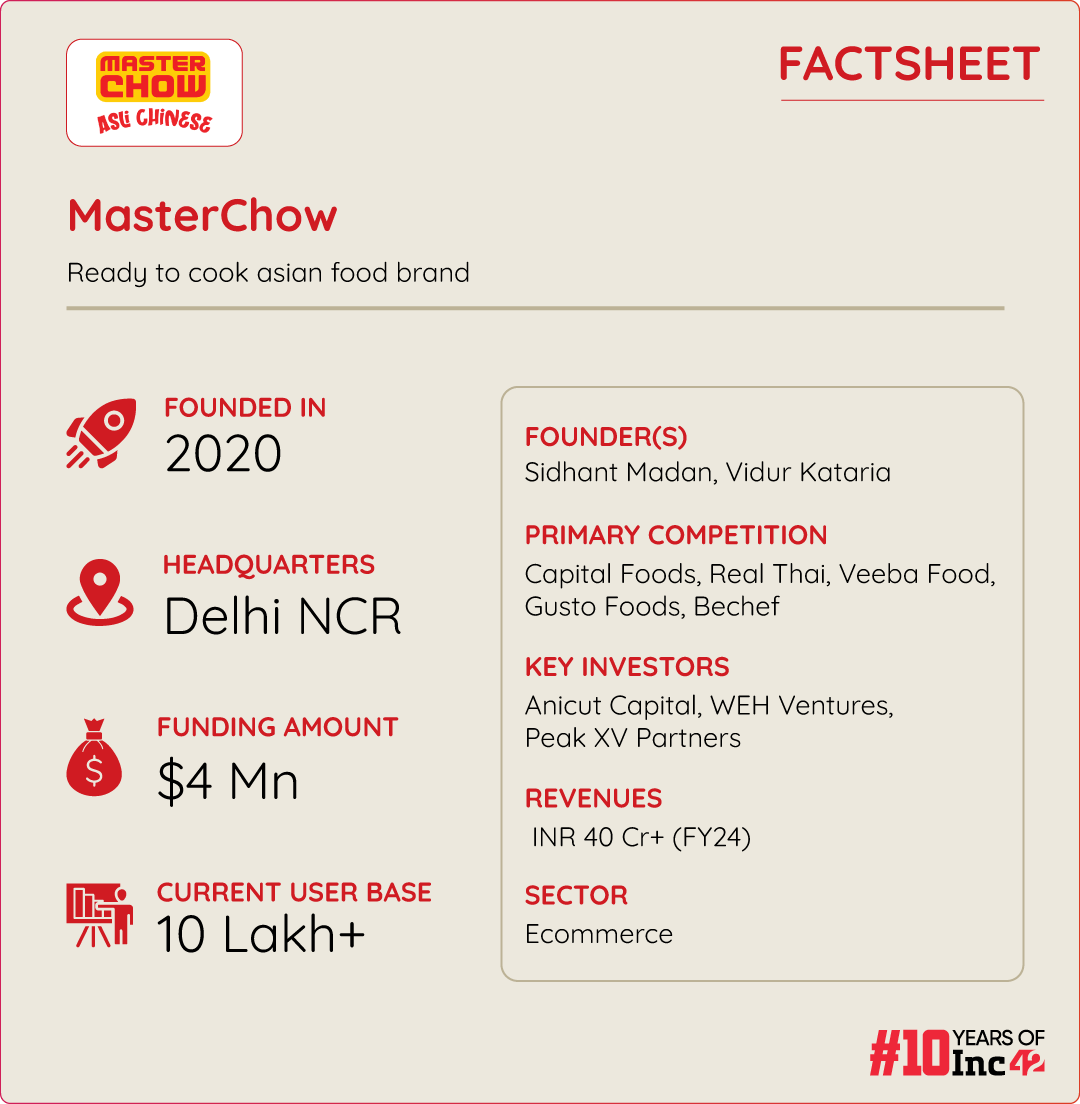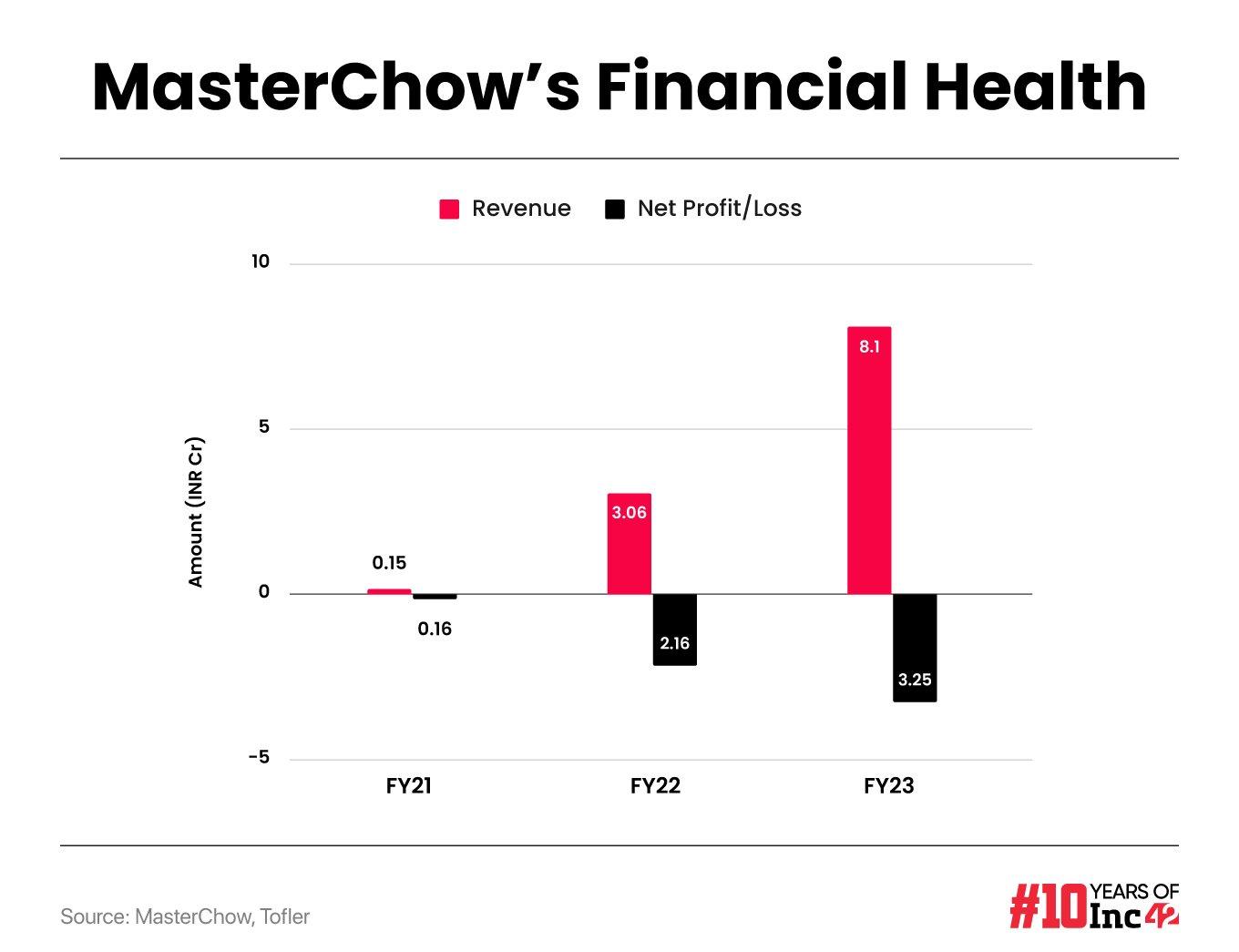Indians love Chinese food so much that we have some of the most flavourful Indian-Chinese fusions available in almost every restaurant or eatery in the country. In fact, Indo-Chinese cuisines are relished so much that around 80% of Indians treat themselves to this cuisine at least once or twice a month.
Not to mention, the amalgamation of the two most-loved cuisines in the world has taken the Indian ready-to-cook (RTC) market, projected to cross $489 Mn by 2027, by storm.
While Capital Foods’ Ching’s Secret has been dominating the Chinese RTC market since 1995, many smaller brands, including Veeba, Gusto Foods, Bechef, and Moi Soi, among others, have now formed a beeline on the back of the growing demand for Chinese food.
Eyeing to capture a major chunk of this market opportunity is a D2C brand MasterChow, which specialises in RTC and ready-to-eat authentic Chinese and Asian foods. Founded in 2020 by Vidur Kataria and Sidhanth Mada, MasterChow provides a wide range of RTC options, including instant noodles, dipping sauces, sticky rice and condiments, among others.
Along with being available on Amazon, Flipkart, JioMart, Blinkit and Swiggy, the D2C brand is present at 2,500 offline outlets, including modern trade stores and self-service stores. It aims to dominate the Asian packaged food category in India and expand to 10,000 stores.
MasterChow’s customer base has grown from a mere 100 to 10 Lakh since its launch.
According to the founder, this growth has helped the company expand its top line by 390% from INR 8.10 Cr in FY23 to over INR 40 Cr in FY24. By 2025, it aims to become an INR 100 Cr revenue-generating brand.
Speaking with Inc42, Kataria said that the brand has been able to achieve much in little time on the back of its unique value proposition, which is — “unlike other brands, MasterChow focusses on offering authentic flavours and handcrafted sauces”.
Also, the brand’s range of speciality noodles and sauces, including gluten-free and vegan choices, as well as meal kits that come with recipe cards for an enhanced cooking experience, is an addition to its brand value.
“However, there’s currently only one major player offering a single type of sauce — Capital Foods. Beyond them, there’s a clear opportunity for market expansion. Our focus is on building a strong brand presence in households and delivering a variety of flavours to our consumers. We are trying to build a narrative that we are ‘Asli’ Chinese (Indo-Chinese),” Kataria said.


The Early Legend Of MasterChow
The inception story of MasterChow stems from Kataria’s craving for Chinese food when he returned to India from the UK in 2015 after completing engineering.
Missing the authentic international Chinese flavours and recognising a gap, where high-quality Chinese meals in India were limited to five-star hotels or specific eateries, Kataria estimated that at least 10,000 to 20,000 international travellers felt the same way.
With this idea, he approached his close friend Madan (now cofounder). The duo then decided to turn their passion for pan-Asian cuisine into a business by opening their first restaurant, Wok Me. Inspired by the QSR chain of Subway, the two set up their first restaurant at Delhi’s Aurobindo Marg in 2016.
“Before launching Wok Me, we spent six months perfecting 58 sauces and refining the flavours of the Chinese cuisine offered by us. We then introduced six signature sauces, allowing customers to customise their meals. After establishing trust with early customers, we expanded to multiple outlets,” Kataria said.
However, they received a big blow due to the Covid-19 pandemic just before opening their sixth outlet and securing their first funding round.
The cofounders were quick to realise that although customers couldn’t come to them during the peak pandemic times, nothing hindered them to connect with their customers. Realising the opportunity, they launched MasterChow, delivering their first order in June 2020.
“Next, we moved quickly with branding and packaging, completing everything in just seven days. My sister-in-law, a designer, led the effort. Within three days, the branding was finalised, stickers were printed, and my house in Saket became a micro-factory where we sterilised bottles, filled, labelled, and dispatched orders,” Kataria said.
MasterChow’s Pandemic Puzzle
During the pandemic, while customer demand for unique foods inspired an innovative idea among the cofounders, it also proved to be the most challenging time for them, as they were uncertain about MasterChow’s future.
“Our entire business model shifted from planning to scale up to six outlets by 2020 to making unanticipated adjustments during the pandemic,” Kataria said.
Despite raising funds, the founders said they were unsure where and how to allocate the funds. However, encouragement from their investors pushed them to take risks, prompting Kataria to become more proactive in his business approach.
“We didn’t foresee what MasterChow would become, but it was crucial to stay afloat during tough times. We made sure to pay salaries out of pocket, refusing to let anyone go,” Kataria added.


While Madan managed orders via WhatsApp, his wife assisted with management and they operated their micro-factory from home, packing orders late at night for morning delivery with the help of a Domino’s delivery guy.
“Covid presented unique challenges — from scaling orders to reaching our first milestone of 250 orders during Rakhi, it became a family affair with everyone pitching in. From producing 12 bottles a day at home, we have grown to produce nearly 10,000 bottles daily in the last three years,” Kataria said.
MasterChow’s Customer Acquisition Strategy
Initially, the cofounders decided to operate only through their website. However, managing D2C wasn’t easy, as it required ensuring timely orders and a strong communication strategy.
They then decided to strategise on enabling same-day or next-day deliveries outside of Delhi, leveraging Amazon for quick fulfilment. By November 2020, they began with Amazon’s Easy Ship model, simplifying order processing and dispatch. When quick commerce gained pace towards the end of 2021, the MasterChow founders decided to make the shift to expand their user base.
As per the cofounder, the key focus at the time was to figure out how to reach the maximum number of households and increase the distribution network.
“Initially, we started with six SKUs, focussing solely on cooking sauces. While this was a good starting point, it wasn’t ideal for a large-scale expansion strategy. We needed to make people understand what MasterChow was and how we make them experience its flavours,” Kataria said.
So, they launched a line of condiments with chilli oil becoming one of their strongest SKUs. Currently, MasterChow has 36 SKUs and offers sauces under four categories covering everything from chowmein and manchurian sauce to condiments and vinegar. Their fifth category is stick noodles.
Another strategy the founders employed was content. They created a community by sharing authentic, relatable content that showcased their journey, including their success and mistakes. They created ads that incorporated humour to engage people and make the brand more relatable. Recipes played a key role, leading to the launch of MasterChow Mondays, a weekly initiative where the cofounder himself uploads videos cooking new recipes with MasterChow sauces.
Kataria shares a recipe video every Monday. “Our Instagram growth is entirely organic and we do not spend a dime on ads,” he added.
In April this year, MasterChow roped in celebrity chef Ranveer Brar as its brand ambassador to establish itself as the leading choice for “Asli Chinese” cuisine.
By leveraging digital platforms like Instagram, Meta, and Amazon marketplace, along with strategic collaborations with influencers, the brand further seeks to enhance its market presence and establish itself as a household name.
MasterChow’s Big Plans
As of now, the startup is focussed on differentiating itself by offering freshly cooked sauces that have little to no additives. In addition, Master Chow aims to stand out by offering a variety of high-quality products to woo health-conscious consumers interested in innovative Asian cuisine options.
“Our focus is on delivering high-quality products, even if it means shorter shelf life of our products. We aim to minimise additives and preservatives and become 100% preservative-free. Our strategy revolves around offering superior taste and variety, leveraging extensive trial activities across offline touchpoints and sampling initiatives to introduce consumers to our products,” the cofounders said.
Going forward, they aim to double down on their sampling activities. They also aim to increase offline touchpoints to 10,000 stores, including self-service grocery stores and supermarkets.
The company has set its eyes on achieving a revenue milestone of INR 100 Cr by FY25.
“In the last four months, MasterChow has grown by 20% month-on-month. We are already 60% towards our goal and on track to reach the INR 100 Cr mark on a monthly basis,” Kataria said.
Apart from this, the brand will soon be launching several marketing campaigns and partnering with major national brands for new product collaborations, including onboarding a new chef.
With its focus on providing authentic Chinese cuisine, it will be interesting to see how MasterChow plans to capture market share from competitors like Veeba, Nomad Food, and others in the coming years.

